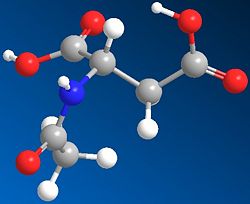N-acetylaspartate: Difference between revisions
imported>Pierre-Alain Gouanvic mNo edit summary |
imported>John Moffett No edit summary |
||
| (5 intermediate revisions by 4 users not shown) | |||
| Line 1: | Line 1: | ||
{{subpages}} | {{subpages}} | ||
{{Image|N-ACETYL-L-ASPARTATE.JPG|right|250px|3-D view of N-acetylaspartate}} | |||
N-acetylaspartate (NAA) is the second most concentrated compound in the human brain | '''N-acetylaspartate''' (NAA) is the second most concentrated compound in the human brain after [[glutamate]]. NAA is synthesized primarily by neurons in the nervous system, however, despite its high concentration, the functions performed by NAA remain uncertain and controversial. | ||
== | Four primary functional roles have been proposed for NAA in the nervous system, including: | ||
NAA is synthesized in neuronal [[mitochondria]] | |||
# Due to its high concentration, NAA acts as a nerve cell osmolyte or osmotic regulator | |||
# Because NAA is manufactured in neuronal mitochondria, it may be involved in energy production by fascilitating respiration on glutamate | |||
# Evidence suggests that NAA is the immediate precursor for the synthesis of the important neuronal dipeptide N-acetylaspartylglutamate | |||
# NAA supplies acetyl groups for the synthesis of fatty acids in the brain, which are required for the synthesis of myelin. | |||
==Proposed role for myelin synthesis== | |||
NAA is synthesized in neuronal [[mitochondria]] by the enzyme Aspartate N-acetyltransferase. It is broken down by the enzyme N-acetyl-l-aspartate amidohydrolase (aspartoacylase), that is located primarily in the white matter cells. Based on the specific localization of this enzyme (in lipid-rich [[myelin]] sheaths) and on the fact that it produces acetyl groups, it has been proposed that the high concentrations of NAA in the brain are to provide a reserve of acetyls for myelin synthesis.<ref name=Chakraborty2001>{{citation | |||
| author = Chakraborty, G.; Mekala, P.; Yahya, D.; Wu, G.; Ledeen, R.W. | | author = Chakraborty, G.; Mekala, P.; Yahya, D.; Wu, G.; Ledeen, R.W. | ||
| year = 2001 | | year = 2001 | ||
Latest revision as of 11:25, 24 January 2010
N-acetylaspartate (NAA) is the second most concentrated compound in the human brain after glutamate. NAA is synthesized primarily by neurons in the nervous system, however, despite its high concentration, the functions performed by NAA remain uncertain and controversial.
Four primary functional roles have been proposed for NAA in the nervous system, including:
- Due to its high concentration, NAA acts as a nerve cell osmolyte or osmotic regulator
- Because NAA is manufactured in neuronal mitochondria, it may be involved in energy production by fascilitating respiration on glutamate
- Evidence suggests that NAA is the immediate precursor for the synthesis of the important neuronal dipeptide N-acetylaspartylglutamate
- NAA supplies acetyl groups for the synthesis of fatty acids in the brain, which are required for the synthesis of myelin.
Proposed role for myelin synthesis
NAA is synthesized in neuronal mitochondria by the enzyme Aspartate N-acetyltransferase. It is broken down by the enzyme N-acetyl-l-aspartate amidohydrolase (aspartoacylase), that is located primarily in the white matter cells. Based on the specific localization of this enzyme (in lipid-rich myelin sheaths) and on the fact that it produces acetyl groups, it has been proposed that the high concentrations of NAA in the brain are to provide a reserve of acetyls for myelin synthesis.[1]
References
- ↑ Chakraborty, G.; Mekala, P.; Yahya, D.; Wu, G.; Ledeen, R.W. (2001), "Intraneuronal N-acetylaspartate supplies acetyl groups for myelin lipid synthesis: Evidence for myelin-associated aspartoacylase", Journal of Neurochemistry 78 (4): 736–745, DOI:10.1046/j.1471-4159.2001.00456.x
